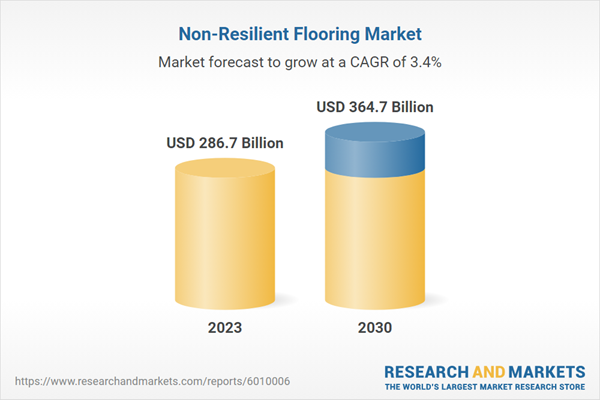The global non-resilient flooring market size is expected to reach USD 364.7 billion by 2030 and is projected to grow at a CAGR of 3.4% from 2024 to 2030. Advanced digital printing technologies for ceramic tiles have led to the development of innovative and versatile products along with improving installation techniques. This has significantly broadened the scope of their application across residential, commercial and industrial flooring market. Rising urbanization and the subsequent increased demand in new construction sector is expected to be the key driving force for the market over the forecast period.
Raw material costs have significantly impacted the non-resilient flooring industry. Ceramic tiles are manufactured out of raw materials that are readily available. However, fluctuations in the prices of raw materials along with decreased margins for manufacturers have led to an increase in ceramic products prices. Natural stones need to be mined, processed into small slabs that can then be used for flooring, thereby making them expensive. Technological advancements in mining and processing of natural and manufactured stone are expected to result in reduced prices over the next six years.
This product will be delivered within 1-3 business days.
Raw material costs have significantly impacted the non-resilient flooring industry. Ceramic tiles are manufactured out of raw materials that are readily available. However, fluctuations in the prices of raw materials along with decreased margins for manufacturers have led to an increase in ceramic products prices. Natural stones need to be mined, processed into small slabs that can then be used for flooring, thereby making them expensive. Technological advancements in mining and processing of natural and manufactured stone are expected to result in reduced prices over the next six years.
Non-resilient Flooring Market Report Highlights
- The ceramic tiles segment is expected to grow at the fastest CAGR over the forecast period. This high demand can be attributed to increased usage in commercial applications such as malls and shopping centers as well as work and office spaces. Among stone flooring, marble and granite are expected to witness high growth. Manufactured stone, concrete tiles and engineered quartz products have significantly contributed to overall industry growth.
- Residential applications contributed to over 55.4% of the overall market revenue in 2023. Exponential increase in property resale has led to an increase in homeowner remodeling and home improvement projects and escalation in the prices of residential property across the globe. This has proved to be an incentive for non-movers to invest in their homes and upgrade to stone countertops and flooring. On account of high growth of the residential sector, stone and ceramic suppliers have targeted online retail channels and home centers.
- Developing markets from Asia Pacific have captured a sizable portion of the overall demand, both in terms of volume and revenue, which can be primarily attributed to rapid urbanization and increasing infrastructure facilities in the region. Increased demand from retail, healthcare and education sectors along with increasing demand from the commercial sector have driven the non-resilient flooring market in North America and Europe.
- Key non-resilient flooring market players such as Ceramica Saloni, China Ceramics, Dal Tile, Mannington Mills, Mohawk Industries, RAK Ceramics, Shaw Industries Group are continually reworking on their distribution channel and marketing strategies in a bid to maintain competitiveness. Manufacturers have laid a strong emphasis on designing display systems, showcasing ceramic tiles collections on their websites, and online catalog for the customers to find out products best suitable for their individual applications.
The leading players in the Non-Resilient Flooring market include:
- Victoria PLC
- Crossville Inc.
- Daltile.
- Kajaria Ceramics Limited
- Mannington Mills, Inc.
- MOHAWK INDUSTRIES, INC.
- PORCELANOSA Grupo A.I.E.
- Shaw Industries Group, Inc.
Why should you buy this report?
- Comprehensive Market Analysis: Gain detailed insights into the global market across major regions and segments.
- Competitive Landscape: Explore the market presence of key players worldwide.
- Future Trends: Discover the pivotal trends and drivers shaping the future of the global market.
- Actionable Recommendations: Utilize insights to uncover new revenue streams and guide strategic business decisions.
This report addresses:
- Market intelligence to enable effective decision-making
- Market estimates and forecasts from 2018 to 2030
- Growth opportunities and trend analyses
- Segment and regional revenue forecasts for market assessment
- Competition strategy and market share analysis
- Product innovation listing for you to stay ahead of the curve
- COVID-19's impact and how to sustain in these fast-evolving markets
This product will be delivered within 1-3 business days.
Table of Contents
Chapter 1. Methodology and Scope
Chapter 2. Executive Summary
Chapter 3. Non-resilient Flooring Market Variables, Trends, & Scope
Chapter 4. Non-resilient Flooring Market: Product Estimates & Trend Analysis
Chapter 5. Non-resilient Flooring Market: Application Estimates & Trend Analysis
Chapter 6. Non-resilient Flooring Market: Regional Estimates & Trend Analysis
Chapter 7. Competitive Landscape
Companies Mentioned
The leading players in the Non-Resilient Flooring market include:- Victoria PLC
- Crossville Inc.
- Daltile.
- Kajaria Ceramics Limited
- Mannington Mills, Inc.
- MOHAWK INDUSTRIES, INC.
- PORCELANOSA Grupo A.I.E.
- Shaw Industries Group, Inc.
Methodology

LOADING...
Table Information
| Report Attribute | Details |
|---|---|
| No. of Pages | 100 |
| Published | September 2024 |
| Forecast Period | 2023 - 2030 |
| Estimated Market Value ( USD | $ 286.7 Billion |
| Forecasted Market Value ( USD | $ 364.7 Billion |
| Compound Annual Growth Rate | 3.4% |
| Regions Covered | Global |
| No. of Companies Mentioned | 9 |









